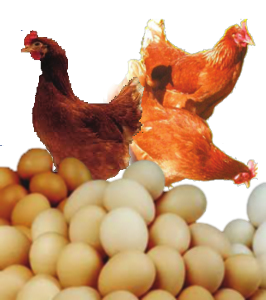 LAYERS PRODUCTION
LAYERS PRODUCTION
Layers are purposely kept for egg production. The routine management of layers at the brooder level is similar to that of the broiler. The behavior of the chicks will tell whether the house is over or under heated.
Stocking rate is set at 2.0sq.ft per bird at the laying period. The laying unit should be filled with laying boxes which should then be placed at the darkest side of the unit so as to discourage egg eating. They (laying boxes) should be of 1 cubic foot in size.
LAYERS FEEDING
- From day old -8 weeks of age: feed with Empire Feeds Chick & Duck Mash with coccidiostat. Feed intake should be 2Kgs per bird up to 8 weeks.
- From the 9 th week- 18 th week: feed with Empire Feeds Growers Mash with coccidiostat. Feed intake should be
7Kgs per bird of the growing period. - 19 th week up to the end of production, period (layer production period): feed with Empire Feeds Layers Mash Plus. Feed intake should be 51Kgs for the period of 1yr in laying. Feed consumption of less than 6.8 per Kg per tray of egg is satisfactory. Feed 140gm layers mash per bird per day.
Empire Feeds Layers Mash Plus is formulated to enhance high egg production and good egg size.
VACCINATION
Recommended program layer
| Day | Vaccine | Vaccination Routine |
| Day old at Hatchery | Marek’s | Intramuscular |
| 3-10days | Gumboro | Drinking Water |
| 21 days | New Castle Disease / IB | Drinking Water |
| 28th Day | Gumboro | Drinking Water |
| 6th Week | Fowl Pox | Wing Stab |
| 8th Week | Fowl Typhoid | Intramuscular (Thigh) |
[nextpage title=”Common Poultry Diseases”]
COMMON POULTRY DISEASES
GUMBORO
Caused by infectious Bursal virus.
Common signs are whitish watery diarrhea, soiled vent, loss of appetite and death within the 1 st two days. Prevention and control is by vaccination and disinfection of premises.
NEW CASTLE DISEASE
Caused by Paramyxo virus.
Signs include high mortality rates, greenish watery diarrhoea, twisted neck, drop in production and soft shelled eggs.
Prevention is by vaccination and disinfection.
MAREK’S
Caused by infectious Bursal virus.
Common signs are whitish watery diarrhea, soiled vent, loss of appetite and death within the 1st two days.
Prevention and control is by vaccination and disinfection of premises.
CHRONIC RESPIRATORY DISEASE (CRD)
Caused by a bacteria Mycoplasma galliscepticum and distress e.g. cold weather marked by respiratory problems.
Symptoms include drop in production, poor shell quality, nasal discharge, coughing and mortality is negligible unless the disease is complicated.
Control and treatment is by adequate ventilation, administration of antibiotics and water soluble vitamins.
COCCIDIOSIS
Caused by Protozoan parasites.
Signs include bloody droppings, ruffled feathers, increased thirst, pale mucous membrane and loss of feathers.
Control and treatment is by maintaining dry litter and use of feeds with coccidiostat in both chick and growers ration.
DISCLAIMER
These are only guidelines: Results will vary based on farmer’s specific management practices.




